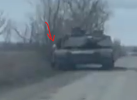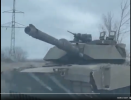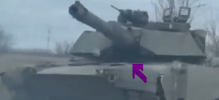https://interfax.com.ua/news/interview/968704.html
14:20 02/21/2024
The nature of the actions of the Russian Federation with the loud name "offensives" implies a protracted war, and this is what the enemy is trying to impose on us, sacrificing a huge number of its people - the deputy head of the Ministry of Defense
10 minutes to read
On the eve of the second anniversary of the full-scale invasion of the Russian Federation into Ukraine, we talked with the deputy chief of the GUR of the Ministry of Defense of Ukraine, Major General Vadym Skibytsky, about the development of the Russian military-industrial complex, the enemy's probable plans and the current composition of his forces.
(Part 1)
Authors: Valeriya Proshchenko, Oleksandr Martynenko
Vadim Vasyliovych, the second anniversary of the full-scale invasion of the Russian Federation into Ukraine is approaching, how have the enemy forces changed during this time?
If we talk about what has changed during this time, then it is the number of groups deployed on our territory. Currently, the ground component, the ground part of the group, which is located on the territory of Ukraine, consists of about 470 thousand military personnel. And this is only the land component, I do not include aviation, we do not count the navy here, which is also involved in conducting operations, in carrying out strikes.
In addition, a new component appeared, which was not present at the beginning of the aggression (it was represented only partially, by battalions). To date, a group of Russian Guard troops has been deployed in the temporarily occupied territories. These are almost 33,000 military personnel. These are the people who ensure the activity of the occupying power, the protection of strategic objects and, if necessary, can perform defense tasks in the temporarily occupied territories.
What else appeared additionally - the so-called grouping "covering the state border" of the Russian Federation. They are deployed on the territory of three regions of Russia, which directly border with us: Belgorod, Kursk, and Bryansk regions. The Russians are afraid that we will be more active, we will carry out appropriate actions on the territory of the Russian Federation. Perhaps it is necessary to move the war to the territory of Russia. There they concentrated a group of about 30,000 military personnel. Recently, they were also reinforced by units of the 116th brigade of the Russian Guard, which was overturned. Three battalions were transferred from our Mariupol to the territory of the Belgorod region, as they also admit, in order to ensure the safety and conduct of the elections of the ever-living Putin. These are the changes that mainly took place in the number of the land component.
Another thing that happened in two years. We essentially isolated the Black Sea Fleet. All major warships are in Novorossiysk. They can only enter Sevastopol to replenish ammunition, reload or, if necessary, when they are on combat duty. And yes, all the activity of the Black Sea Fleet is near the coast of Crimea or in the eastern part of the Black Sea. To date, we have fully ensured the ability to control in terms of fire, the ability to strike the Black Sea Fleet if it enters the northwestern part. And this gave us the opportunity to restore the sea corridor, along which grain and goods now go.
In two years, we liberated many territories that Russia was counting on from the very beginning of the aggression. And most importantly, the strategic goal of the Russian Federation, and even more so the complete occupation of Ukraine, has not been achieved. We completely violated the plans that Russia had in February 2022.
One of the main tasks that the Russians set before themselves - the so-called "release or assistance to Luhansk People's Republic, Donetsk People's Republic" has not yet been implemented. Two years have passed, and the Russians have not reached the administrative border of either the Luhansk or Donetsk regions. And because of that, we now see the activity of the enemy, which is connected with the fact that, at least before the presidential elections of Russia, we can demonstrate some significant result. I am sure that Avdiivka will be submitted to the elections as an incredibly great strategic victory. Although we understand that this is not a strategic victory at all. Due to this, they simply pushed our troops away from Donetsk.
And in what ways have Russian terrorists become weaker/stronger?
Two years of full-scale war, and we clearly know that a stronger force has emerged in the Russian Federation, and where they are lagging behind. We can name three strengths that the enemy has and which he uses.
If taken at the national level: Russians have a powerful mobilization resource. They have no shortage of men to take part in the war. This is connected, first of all, with the financial side of this issue. The financial motive remains the main one, especially in regions with a poor economy, few jobs and low wages. The package of social assistance adopted by the Russian Federation is very powerful. Among other things, it includes a high salary, especially if the serviceman performs tasks on the front line, one-time assistance from the Ministry of Defense and from local authorities, as well as significant concessions in lending. In addition, an important factor is criminal liability for evasion of military registration, for desertion, for surrender. I'm not talking about espionage and the rest.
The next strong point is that due to the large number of Russians, they have the ability to take troops into reserve to replenish losses and rest, and also to move or regroup troops from one direction to another. I will give Avdiivka as an example. They withdrew troops from the Lymansky, Kupyansky directions and threw them at Avdiivka. That is, the Russians can throw reserves in the most critical directions from their point of view. And the movement of troops, regrouping, they practiced all the time during strategic exercises in the Russian Federation, during other operations of operational combat training.
The third strength of the enemy is aviation and dominance in the air, because every day the enemy uses aerial bombs. For example, the most we counted in one day was 75 air bombs, 500 kilograms, were released on Avdiivka. In addition, you can see that every day there are attacks by the same Kh-31, Kh-59, guided missiles on our facilities. First of all, the Russians are trying now to destroy our air defense system, our weapons-carrying aircraft, and to destroy our airfield network so that we cannot use our aircraft. This is a strong point, which today has a very significant effect on the battlefield, on the conduct of hostilities.
As for the weaknesses - I won't tell you the weaknesses. Because the enemy will understand, and he will simply neutralize these weaknesses. But they have many weaknesses. They are related to both administrative issues of the management of the armed forces and equipment and weapons. We know all this, we take everything into account. Our troops are aware of this. Our strength is that we know the plans of the enemy.
In January, you emphasized that the enemy currently does not have enough reserves to carry out powerful strategic offensive operations in at least two or three directions at the same time. However, recently, more and more often, in particular, in the Western media, information about the preparation of offensives, either on Kupyansk, or on the Zaporizhzhia direction, appears. What information does intelligence have about this?
When we talk about conducting a strategic operation, the Russian Federation clearly cannot conduct it in two directions now. What categories do we operate in? First of all, before the start of the war, the strategic directions for the Russian troops were defined, which in principle remain, and what a strategic operation is defined.
A strategic operation is an operation carried out in a separate strategic direction. In the direction of Ukraine, the Russian Federation had at least two strategic directions. This is the southwestern strategic direction - the area of responsibility of the Southern Military District. And the Western strategic direction is the responsibility of the Western Military District.
Kharkiv, Sumy, Chernihiv, Kyiv region are the western strategic direction. The cities where active hostilities are currently taking place are the southwestern strategic direction. To date, Russia continues strategic operations in only one direction. It has no troops, no forces, and no means to conduct a powerful offensive operation in the western strategic direction. The Russian Federation currently does not have a strategic reserve, they are trying to create one. Everything that was created was immediately brought to our territory. The 18th Army, the 25th Army, the 3rd Army Corps - they are all fighting, there is no reserve.
If we are talking about what should be the pace of the offensive in a strategic operation? For a day, this is an advance of 20 km deep into the enemy's territory. The occupiers of Avdiivka took more than four months, what kind of strategic offensive can we talk about? Yes, these are tactical measures carried out by small tactical groups, assault squads, it goes on continuously. There have been changes in the tactics of actions during these two years, unequivocally. At first, the Russians went to act in battalion tactical groups, and today they have returned to the usual tactics of assault operations. These are again brigades, regiments, divisions, armies, corps. That is, they returned to the classical structure inherent in a conventional conventional war.
That is why we say that Russia is not capable of conducting strategic offensive operations simultaneously in two directions. Actions of a tactical, operational-tactical nature are possible. But it takes time. They took Bakhmut for more than a year. And now there is a lot of talk about the Orihiv direction. To date, there is a result that we achieved during the counteroffensive operation, and the enemy did not push us back there. They did not return to the positions they were in at the beginning of our offensive actions. Thus, there are active actions with the use of aviation, artillery, the destruction of our individual positions, there is no advance.
The main efforts of the Russians are now concentrated on Avdiivka, Kupyansk, and Lyman. Why? Because the task that stands for the next six months will remain unambiguously the same - access to the administrative borders of Luhansk and Donetsk regions. And the second is the maintenance of captured territories. The enemy has captured part of the Kherson region, part of the Zaporizhia region, and they will try to keep them, because they need a land corridor to the Crimea, a logistics system that goes through the Crimea, transportation of ammunition, equipment, and personnel to the south. We destroy large landing ships, they no longer carry anything. If there are 4 or 5 of them left there, they too will be drowned.
Therefore, the task of the enemy is to keep under control the territories they have captured. And containment is, therefore, an active defense or pushing us back to the positions from which we started our offensive actions. And then we understand how important it is for us to have reserves, how important it is to have the support of our partners, to develop our production. Because this nature of the actions of the Russian Federation with the loud name "offensives" predicts a protracted war. A war of attrition. And this is what the enemy is now trying to impose on us, sacrificing a huge number of his people.
So before the "elections" of the president of the Russian Federation, to which there is not much time left, what exactly will the enemy try to achieve?
Before the elections, they specifically want to enter, at least, the administrative borders of the Luhansk region. To have at least some success, something like Avdiyivka, maybe somewhere else in some direction. The key points are: Kupyansk, Lyman, Avdiyivka. And why Kupyansk, Lyman? To show that it was possible to return those territories that were liberated by Ukraine after the start of full-scale aggression. Because it will be symbolic. This is an element that will be very actively used in information and psychological operations, actions, information space.
You have emphasized many times that Russians learn well and quite quickly. We know that Crimea is a "painful" topic for them, and Ukraine inflicts significant losses on the occupiers. But the enemy can learn to defend himself against our successful actions.
That's right, they defend themselves, and we come up with new approaches. As an example, we reached the Crimea, landed a landing force. At first, they reached Sevastopol, Feodosia, and the Crimean Bridge. What did the Russians do after that? They first began to strengthen anti-aircraft defense, create anti-sabotage, so-called "anti-terrorist" groups, conduct training. Doesn't help. Next, they began to build boom barriers, to sink ships so that our unmanned vehicles could not "override" these boom barriers. Then they began to use other means to prevent damage. Nothing, we impress.
You see that they dispersed the ships. At first, they transferred everyone from Crimea, some to Novorossiysk, some to Feodosia. Now Feodosia has also been removed. Next, we began to destroy their arsenals, warehouses with ammunition on the territory of Crimea, and they began to transport ammunition to the territory of Russia. That is, we use new approaches to achieve results.
I will give another example - FPV drones. We started using FPV drones, and the occupiers also realized that this is a very powerful weapon at the tactical level. They are also now establishing a powerful production of FPV drones, no less than ours, if not more. And if unmanned aerial vehicles and FPV drones begin to develop, then the development of radio-electronic warfare means increases. This is a comprehensive approach. There are means of electronic warfare at the strategic level, operational-tactical, and tactical. In order to fight FPV drones, both we and the enemy have to develop, and small tactical-level means of radio-electronic warfare have begun to be actively implemented. We calculated that today Russia uses about 70 types of tactical electronic warfare devices. This includes three classes: portable; those that are placed on the equipment; and portable (gun-type). Of the 70 types, the most widespread are four types: "Lisochek", "Siloc", "Volnorez", "Triton". (nimet ukrainaksi “Лісочек”, “Сілок”, “Волнорез”, “Тритон”.)
Any terrorist act can now be carried out at the expense of drones. And if there is no powerful means of electronic warfare that can either neutralize or destroy UAVs, there will be no result in the fight. And this is the result of two years of war.
In September, you reported that the Russian Federation deployed 46 launchers of the "Iskander" missile complex along the border with Ukraine, what is the number as of now?
Added two more launchers. Not much can change. Their production is small. There were 46, now there are 48. Two launchers were added, they made an additional tactical group, which is used for launching ballistic missiles from the territory of Russia.









